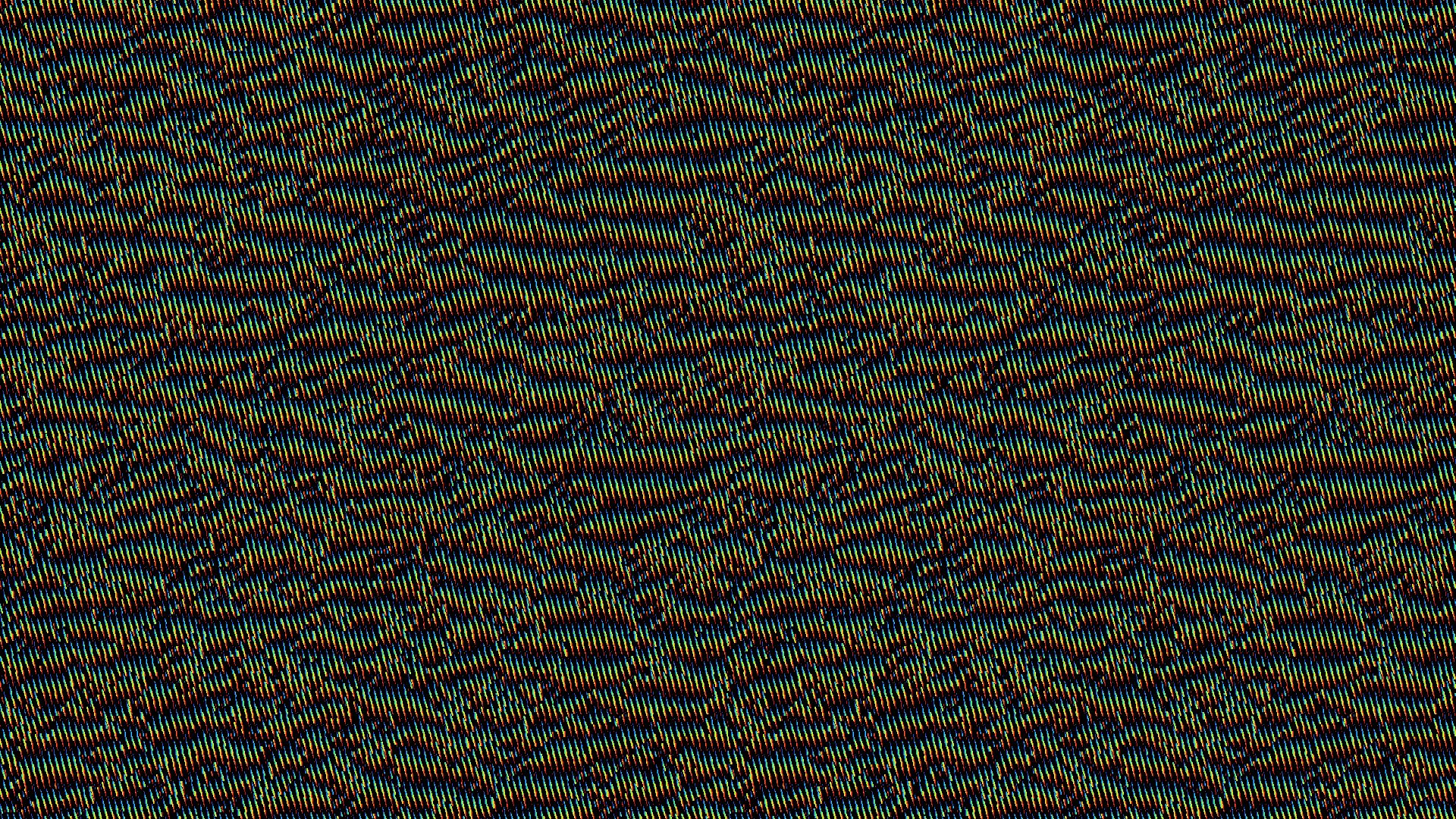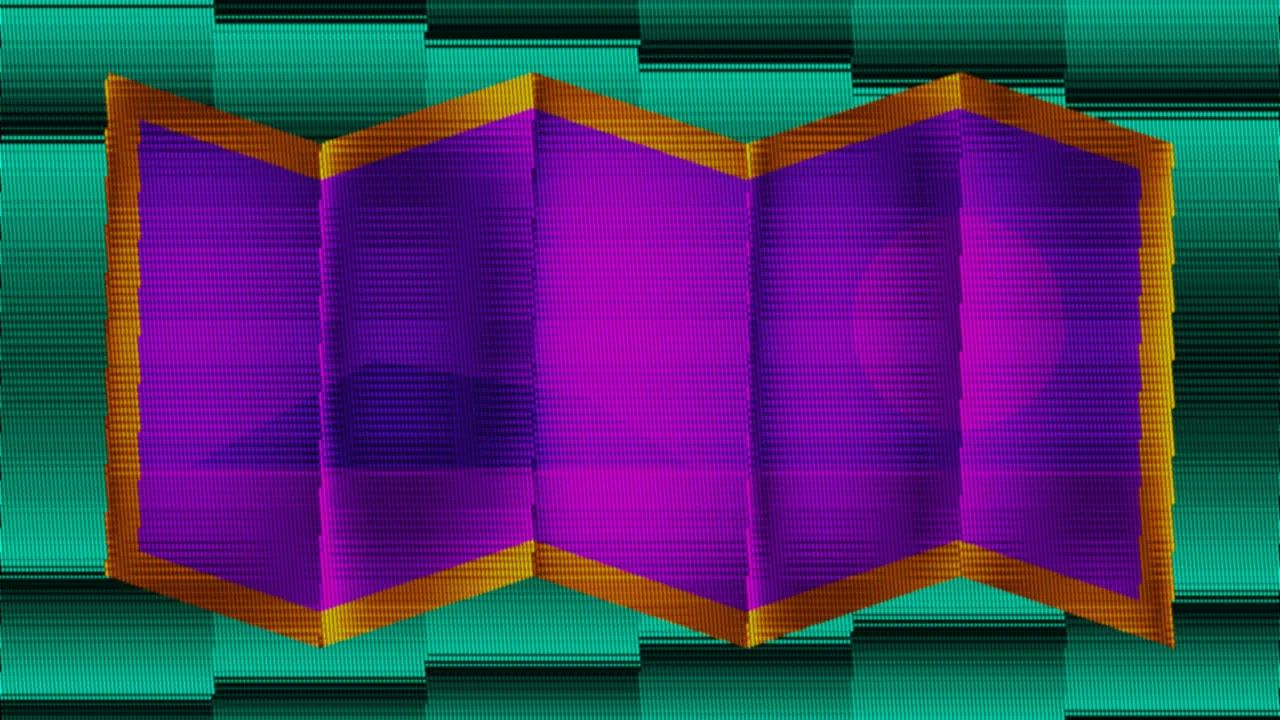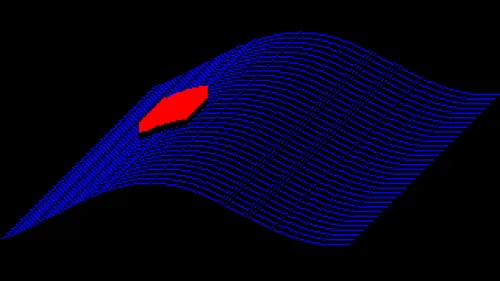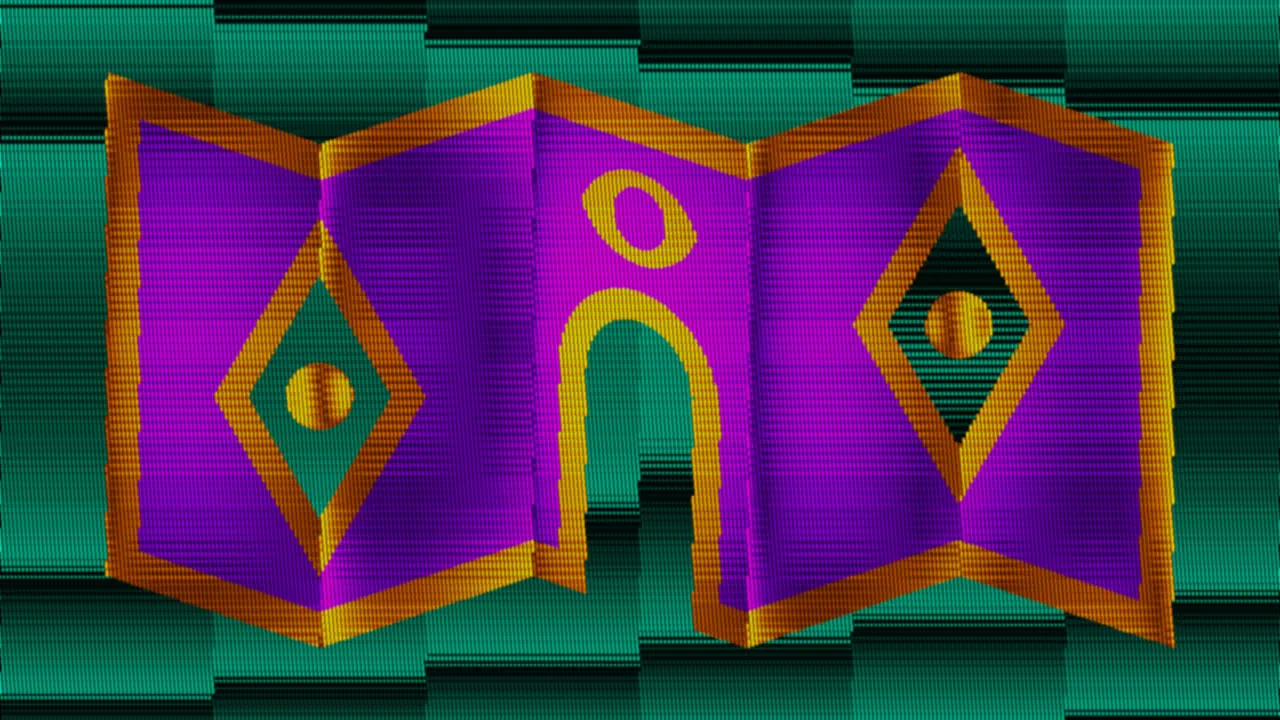Subscribe to get the latest on artists, exhibitions and more.
Sites for the imagination: Nicolas Sassoon in conversation with Alfredo Cramerotti

Nicolas Sassoon in conversation with Alfredo Cramerotti and Mimi Nguyen.
Alfredo Cramerotti: What are the main guiding principles behind your work in general? Can you step outside yourself for a moment and let us know what you see?
Nicolas Sassoon: My work employs a visual language informed by early computer graphics to render a wide array of forms and figures, including abstract all-over animations, architectural studies, and landscapes, among others. This focus on early computer graphics is driven by the sculptural, material and pictorial qualities of the imagery I use, as well as its limitations and its poetics.
A basis of my research centres on digital animations created using a moiré patterning technique; consisting in the overlap of two images to generate the illusion of a third. This research features abstract animations often named after atmospheric and natural forces. The animations appear on screen as endless hypnotic surfaces, similar to all-over paintings or wallpapers in their composition. The strong optical properties of these works generate tensions and oscillations in the perception of depth and flatness within the space of the screen. These works also manifest in physical space as monumental projections scaled to the architecture in context, generating an experience adjusted to the human body. At large, this body of work relates to many histories of abstraction in painting, optical art, moving image and computer graphics. Natural forms are mediated using a language of digital abstraction to generate visual experiences reminiscent of both the natural and the digital.
Another part of my practice explores the representation of digital architectures and landscapes as fantastical figures, structures detached from physical contingencies. I explore technical imageries relating to the production of architecture, design and landscape, and re-appropriate these imageries for their ability to express poetic notions. Technical drawings, architectural renderings and scale models are used for their ability to suggest structures in a transitory state, in between virtual and physical, reality and imagination, utopia and dystopia. The works I’m exhibiting with Verse are related to both of these bodies of work. GATE and SCREEN are created using moiré patterns and are inspired by Japanese folding screens and videogame architectures. At large, they represent imaginary structures as sites for one’s imagination.
Mimi Nguyen: What was the inspiration for SCREEN and GATE?
Nicolas Sassoon: SCREEN and GATE's visual style draw from 16-bit era computer graphics and optical art to create a seemingly paper-thin architecture playing with our sense of perspective, light, and depth.
Both works are informed by many of my experiences of early computer graphics and video games at a young age. They consider the affinity for escapism, dreamscapes, symbolic architectures, and liminal spaces built upon these experiences. Growing up in the 80s, 8-bit and 16-bit graphics played a significant role in the shaping of imaginary worlds – means of escape from reality, where the space of the screen was a two-dimensional portal leading into multi-dimensional universes. These works are a reflection on the quality of these universes, with their game-like appearance and elements of personal mythology. The architectural form is both symbolic and a space of projection. As mentioned, they draw inspiration from Japanese folding screen furniture and eighties dark fantasy films. GATE, as a screen and portal, and together with SCREEN operate within a broader tradition of artworks as sites for the imagination.
Alfredo Cramerotti: Can you dive a bit into the technical aspects of the works? Software or hardware used (in the wide sense; it could be thoughts and bodies), as well as the editing process? What are some of the particular challenges you and your team have faced in realizing the works?
Nicolas Sassoon: I work alone and the tools I use are similar to analog tools for animation but rearranged in a digital workflow. I use Photoshop, Flash (Animate), and 3D programs to draw pixelated patterns and textures, to animate frame by frame, and to render simple geometric shapes. I also constantly produce catalogs of textures that I can reuse in future works. When starting a new project, the first thing I do is gather image documentation on my inspirations and references. With GATE and SCREEN, the artworks were first sketched in a notebook, then I compiled reference images and made a selection of textures to be used in the animations. In both works, I tried to replicate the structure of a folding screen in isometric view and integrate architectural or landscape elements within them. I kept the composition simple since the textures always bring a lot of visual complexity. Throughout this process, I created multiple versions of each work over the span of 4 weeks, trying different color palettes, compositions, motions, and speeds. I always proceed this way: I create as many versions as possible and aim to exhaust all options before selecting the final artwork. The challenging part is often to allow myself some time away from the works before making this selection.
Alfredo Cramerotti: Can you tell us about the relationship you want or aim to have with the viewer? What is the underlying approach to this relationship?
Nicolas Sassoon: My current practice has emerged from publishing animations and digital sketches online in the mid-2000s, which has shaped my relationship to viewership around an economy of attention. Showing artworks online has always been very different from showing artworks in exhibition spaces; you have to compete with other visual content and you need to develop strategies around that. I’ve always been interested in visual forms with strong optical properties such as optical art and early computer graphics, for their formal qualities and for how they grasp the viewer’s attention.
Another important point in my relationship to viewership is the use of screens as displays for aesthetic experiences. I consider screens very important spaces for such experiences. In our daily lives, personal and public displays are mostly used for advertising, entertainment and utilitarian reasons. My work aims to offer a counterpoint to this, by generating moments of pause where the screen becomes a space for contemplation, projection and reflection.
Mimi Nguyen: In our last talk for ArtReview you said you’re quite excited for what the technology will bring us, especially in terms of art experiencing and art curating, and that it can become more “intimate”. You had previously curated four national pavilions at the Venice Art Biennale, and will work with Auronda Scalera on the next Decentral Art Pavilion. How do you think blockchain will transform the contemporary art world and what does it mean for artist like Nicolas Sassoon?
Alfredo Cramerotti: I do believe in the blockchain to be transformative from a number of perspectives. It enables a decentralised structure of the art world, and a potential transparency (with some caveat) that is currently the ‘oblique' side of the art market, and the reason why so few people (comparatively to other sectors) understand the mechanisms of it. It enables the possibility to access the art world itself beyond the established categories, gatekeeping and career paths, and I find this possibly the most relevant in our current generation. Ultimately, it also allows that mentioned intimacy, as works of art can be experienced on an individual, personal level without the need to jump through the hoops of dedicated spaces and institutions for the display and mediation of art - though these structures / frameworks will still be important in terms of cultural validation, and the curatorial scholarship key in linking the blockchain technology and the institutional cultural spaces. We are not getting rid of galleries and museums, in short - but we are expanding them to a totally another level through the blockchain. And this, for artists such as Nicolas, is an exciting prospect.
See the works of Nicolas Sassoon on Verse's exhibition "Magical Realism: Part II" on Tuesday 20 December at 6:00PM BST | 1:00PM ET
Nicolas Sassoon
Nicolas Sassoon is a Franco-Canadian artist using early computer graphics to create a wide array of pixelated forms & figures, moiré patterns & architectural structures. His work has long been concerned with the tensions between the pixel and the screen, reflecting on their entanglement and materiality by constraining himself to experiment with pixelated patterns and figures as his sole visual...
Mimi Nguyen
Mimi is a Creative Director at verse. She is a assistant professor at Central Saint Martins, University of Arts London where she leads the CSM NFT Lab. Her background is New Media Art, having previously studied at the Berlin University of the Arts (UdK) and Academy of Fine Arts in Warsaw. She now also teaches at Imperial College London, Faculty of Engineering, where she leads Mana Lab - a “Future...
Alfredo Cramerotti
Alfredo Cramerotti is Director of MOSTYN Wales; Head Curator of APT Global–Artist Pension Trust; Associate Curator of CCANW–Centre for Contemporary Art and the Natural World; Advisor to the British Council Visual Arts Acquisition Committee and the Art Institutions of the 21st Century Foundation; Vice-President and Executive Committee Member of AICA–International Association of Art Critics; Member...



